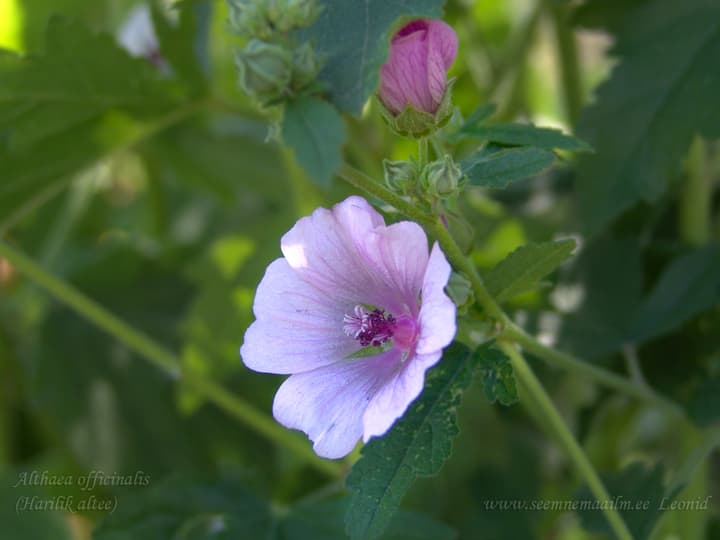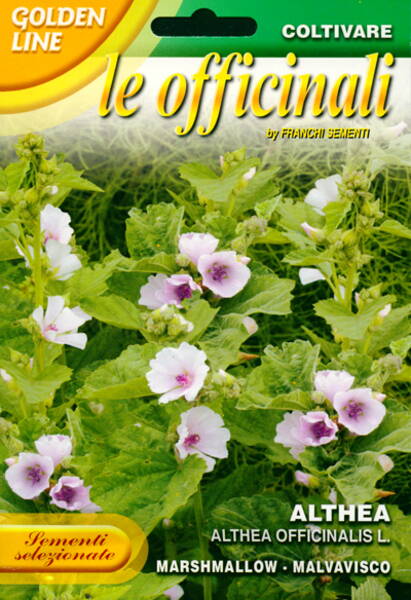It is used as a mild expectorant (especially in children's practice), an anti-inflammatory agent for acute and chronic diseases of the respiratory tract, gastric ulcer and duodenal ulcer.
Marshmallow herb contains 35% mucus, starch, pectin, minerals. The high content of mucous substances allows the preparations of marshmallow to cover the mucous membranes of the body with a protective layer for a long time, protecting them from further damage, while facilitating the spontaneous regeneration of damaged tissues, and reducing the inflammatory process.
Marshmallow has an expectorant, analgesic, antitussive effect. In medicine, teas are used from flowers, leaves and roots of marshmallow.

It is used as a mild expectorant (especially in children's practice), an anti-inflammatory agent for acute and chronic diseases of the respiratory tract, peptic ulcer of the stomach and duodenum. Marshmallow grass contains 35% mucus, starch, pectin and minerals. The high content of mucous substances allows marshmallow preparations to cover the mucous membranes of the body with a protective layer for a long time, protecting them from further damage, while facilitating the spontaneous regeneration of damaged tissues, and reducing the inflammatory process. Althea has an expectorant, analgesic, antitussive effect. In medicine, teas from the flowers, leaves and roots of Althea are used.
Agricultural technology.
Seeds are sown in autumn on seedling beds or in February-March for seedlings. Seeds require preliminary stratification: sow seeds to a depth of no more than 0.5 cm, moisten from a spray bottle, cover with glass and place in a refrigerator (temperature + 5 + 7 °C). Crops are kept under such conditions for 10-15 days, then transferred to room conditions. It is necessary to monitor the humidity of crops and ventilation. At a temperature of + 18 + 20 °C, shoots appear on the 10-14th day. If there is no germination, repeat the "cold-heat" method in the same sequence. Seedlings dive into boxes in the phase of 2-3 true leaves. Seedlings are planted in the open ground after 4-6 weeks. Prefers sunny places or light partial shade with loose, non-acidic soil. In one place it can grow for 5-7 years.

* The name of the plant "marshmallow" comes from the Greek word "althea", which literally means "one that heals." This alone indicates that the ancient Greeks and Romans knew this plant very well and widely used it for medicinal purposes five centuries before our era.
Marshmallow officinalis is a perennial herbaceous plant. Its straight, upward-pointing stems reach a height of 1.2-1.5 meters. In the wild, this plant is found among shrubs, in wet meadows and in floodplains, where groundwater comes close enough to the surface, usually forming small groups of plants.
Althea roots are mainly used as medicinal raw materials. Its rhizome is thick, short, and many-headed, with a powerful tap root up to 50 cm long, which is woody in the upper part. Althea's roots are fleshy and whitish. The stems of Althea are slightly branched and woody in the lower part, the leaves are velvety-felt from dense short pubescence. Because of this pubescence, the whole plant has a greyish-green colour.
The plant blooms in the second year. Pale pink flowers are found at the top of the stem, as well as in the axils of the upper and middle leaves.
Marshmallow blooms for a very long time: from June to September.
Althea roots have an exceptionally rich and unique chemical composition. They contain mucous substances up to 35%, starch - up to 37%, a lot of pectin substances, as well as fatty oil, sucrose, asparagine, betaine, etc. Due to the fact that infusions and decoctions from the marshmallow root have pronounced protective, enveloping, anti-inflammatory and emollient properties, and also have an expectorant effect, they are primarily used for lung diseases since they soothe a painful cough well. That is why marshmallow root has long been a part of chest preparations and children's cough medicine, and effective cough medicine, mukaltin, is made from marshmallow herbs.
Marshmallow root is also widely used in the treatment of gastritis and peptic ulcers of the stomach and duodenum, especially with the increased acidity of gastric juice. The mucous substances of the root envelop the affected areas of the mucous membranes, creating a protective layer and favourable conditions for the healing of the affected areas. At the same time, they also have an anti-inflammatory effect.
In folk medicine, an infusion of marshmallow root is considered a good remedy for pain in the intestines and inflammation of the bladder. And externally, the infusion is used for gargling, washing the eyes and poultices.
To prepare a medicinal decoction of marshmallow roots, you need: 2 tbsp. spoons of crushed raw materials pour 1 cup of hot boiled water, heat in boiling water for 30 minutes, then cool at room temperature. Take warm in a third of a glass in slow sips 3-4 times a day after meals. This prepared broth can be stored in the refrigerator for no more than two days.
Marshmallow root is extremely widely used as part of numerous therapeutic antitussive preparations. For bronchitis and bronchial asthma, a collection is used, consisting of equal parts of marshmallow root and thyme herb. To get the infusion you need: 2 tbsp. spoons of crushed collection pour one glass of cold water, leave for 2 hours, bring to a boil, cool and strain. Take an infusion of one-third of a glass 3 times a day 30 minutes before meals.
For bronchitis, pneumonia and tracheitis, a collection is used, consisting of marshmallow root - 2 parts, coltsfoot leaves - 2 parts, oregano herbs - 1 part. To obtain an infusion, you need 1 tbsp. pour a spoonful of the crushed mixture with one glass of boiling water, leave for 2 hours and strain. Take an infusion of half a glass 3-4 times a day 30 minutes before meals. For the same diseases, a collection is used, consisting of equal parts of marshmallow root, liquorice root and elecampane root. To get the infusion you need: 1 tbsp. pour a spoonful of heavily crushed mixture with one glass of boiling water, insist in a warm place for 1 hour, strain. Take an infusion of half a glass 3-4 times a day 20 minutes before meals in a warm form.
Eng.: Marshmallow, mortification root, white mallow, wymote. Pharm.: Radix bismalvae, radix hibisci. Bot. syn.: Althaea taurinensis DC.












